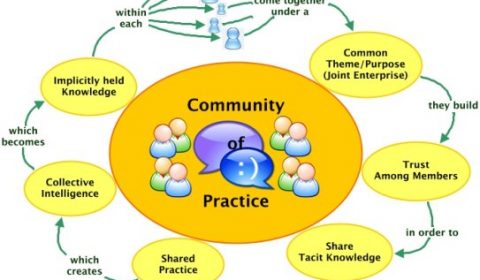Lately, I have been learning about Communities of Practice (CoP). Wenger defines a community of practice as a group of people who share a concern or a passion for something they do and learn how to do it better as they interact regularly. This definition reflects the fundamentally social nature of human learning. I am experiencing a level of collaboration and learning not known.
Working with the participants in Online Learning Consortium course for Professional Foundations and the ID2ID CoP for Instructional Designers are fantastic Sharing information in such groups has influenced ideas I have regarding Instructional Design. Working with my colleagues in the OLC course helps me to understand learning theories much better and their importance as well as how to use them in course design. For example, the importance of using concept maps to visually document learning theories as it applies to effective instruction.
The ID2ID program helps me answer questions faculty have or may ask. One faculty asked me if other instructors have assignments or tests due on holidays or the day after. My colleges from ID2ID suggested avoiding the practice. But one replies made a distinct impression.
If you plan to accommodate/respect holidays, are you sure you are respecting/aware of all the holidays that are observed by your students? Do you know who your students are? What cultural/religious practices they observe? And if in an online course, do you know what the local holidays are, where your students are located?
How can I apply my new knowledge? I can improve our Professional Development program by encouraging faculty how learning theories integrate into course design. I can speak to how learning theories give ideas for practical use of activities such as discussions and assessments. Our faculty is very interested in new ideas and practical solutions for concepts they have. I believe faculty will appreciate the research-based practical ideas.
Improving my Instructional Design skills are a continuing process. I am interested in the pedagogical use of technology in education. Specifically analyzing the characteristics of existing and emerging technology and the potential use. Through the CoPs I have learned of the TPAK and SAMR models. TPACK is a framework that combines three knowledge areas: technological knowledge, content knowledge, and pedagogical knowledge. This framework looks at how this trio works together to increase student’s motivation and make the content more accessible to students. SAMR is a framework through which you can assess and evaluate the technology you use in your class. ID2ID sponsored a webinar titled, Synthesizing TPACK and SAMR Frameworks: A Structure for Intentional Technology Integration. Because of my interest in using technology in learning, I know these models will be invaluable.
I certainly recommend that faculty participate in Communities of Practice. The value of being a part of such a group is incredible.
